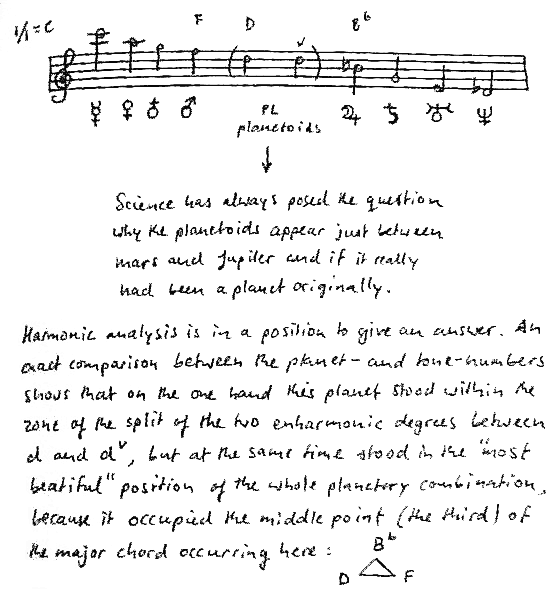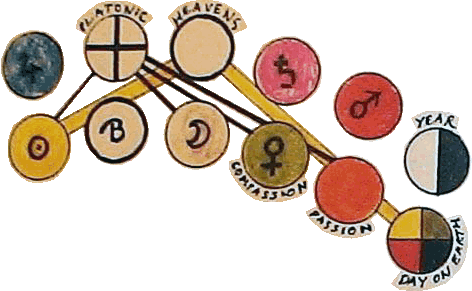harmony of the Spheres
by Moreh

Everything is in a state of vibration: light, sound and "physical matter". We are complexes of vibration surrounded by other transmitters and receptors of vibration. Together, all of it forms an ever-evolving orchestra.
harmony of our lives
One of the most fundamental frequencies in our lives is the circadian rhythm of day and night. It is the 24-hour cycle that rules the biochemical and physiological processes of living entities. Expressed in Hz (cycles per second) you could say it has a low frequency: 1.16E-05. Any tone or frequency finds its reflection in the next octave. Like an overtone, it resonates at the same frequency as the base tone:

In the same way, it is possible to determine the overtone of the circadian rhythm. The 23rd overtone has a frequency of 194 Hz, a tone that lies comfortably within the hearing range. If you would continue doubling the frequencies you would eventually leave the audible spectrum and enter the light spectrum. In that way, some philosophers relate specific colours to planetary (rotation) frequencies. But let's return to the realm of sound. We have stated that there is nothing but a network of vibrations underlying the solidity of matter. Speculative music goes further and asserts that the whole cosmos is audible in its superior modes of existence just as heaven and its inhabitants are visible to certain mystics when no light vibrations are striking the eye.
the cosmos as orderly system
Before dealing with the subject of how to apply this knowledge, one must understand two things: 1) the cosmos as an orderly system rather than chaos, and 2) the significance of celestial influence on our bio-psychological system. Let's start with the first point. Our little solar system is neatly arranged, like tones in a chord. The distances of the planets to the Sun follow a neat mathematical order which is described by Bode's Law:
Assign a number to each planet in order starting with Mercury.
(counting the asteroid belt between Mars and Jupiter, which most probably used to be a planet too). Then pick a planet and add 4 to its number, then divide by 10. This gives you the planet's distance in Astronomical Units from the sun.
0...........Mercury
3...........Venus
6...........Earth
12.........Mars
24.........Asteroid Belt
48.........Jupiter
96.........Saturn
192.......Uranus
384.......Neptune
768.......Pluto

Pythagoras was the first to coin the term "Harmony of the Spheres". It reflects the idea that the whole cosmic plan has an intimate connection between the laws of mathematics and of music in time and space. Aristotle characterizes the Pythagorean philosophy as having reduced all things to numbers or elements of numbers, and described the whole universe as "a Harmonia and a number". This idea was later studied by Kepler, and still, in present times, this science and the relationship with the Golden Ration are being yet further investigated.
This brings us to the second point that needs to be understood: the celestial influence on our bio-psychological system. The central nervous system and the regulation of endocrine glands as transformers of life energy are intimately connected to the circadian rhythm. Several researchers (for example, Rodney Collin) go further and relate various functions in the body of man to specific planetary influences. Without going into detail, it is safe to establish that man as a microcosm is connected to the macrocosm in which he/she lives. The day and night, the cycles of the moon, but also possibly finer vibratory forces transmitted by the planets.
application
Once you adopt the idea that sound (or vibration in general) can have an equilibrating and harmonizing effect (as well as a disturbing effect), the science of harmony can be applied to bring greater balance into one's life or to attune to specific energies. There is a form of absolute and relative harmony. Absolute harmony can, for example, be determined by the tuning of an instrument. The ancients tuned their instruments at an A of 432 Hz instead of 440 Hz - and for a good reason. There are plenty of music examples on the internet that you can listen to establish the difference for yourself. Tuning an instrument to 432 Hz results in a more relaxing sound while 440 Hz slightly tenses up the body. This is because 440 Hz is out of tune with both macrocosm and microcosm. However, 432 Hz is in tune and resonates naturally. To give an example of how this is manifested microcosmically, our breath (0,3 Hz) and our pulse (1,2 Hz) relate to the frequency of the lower octave of an A of 432 Hz (108 Hz) as 1:360 and 1:90.

It is interesting to note that 432 Hz was the standard pitch of many old instruments and that it was only recently (19th and 20th centuries) that the standard pitch was increased to 440Hz. This was done in order to be able to play for bigger audiences. Bigger audiences (more physical bodies) absorb more of the lower frequencies, so the higher pitch was more likely to "cut through".
One of the oldest instruments in the world is the bell ensemble of Yi Zeng (dated 423 BC). It is tuned to a standard F4 of 345 Hz which gives an A= 432 Hz. The frequency of 345 Hz is that of the platonic year! Similarly, many old organs are tuned to an A=432 Hz as well. (For example, St. Peter's Cappella Gregoriana, St. Peter's Cappella Giulia, and S. Maria Maggiore in Rome have organs tuned to an A of 432 Hz.) In the above calculation from F to A, I have used the calculation of equal temperament. For those interested in various temperaments like Just Intonation, for example, an entirely new field of harmonics is opened up. After many years of research, I have found a system of tuning that allows everything to fall into place.
the key
I would like to share a little bit about this system of tuning, just enough to get any serious student started. Below is a picture of the planetary situation laid out on the custom made drone instrument (concertina) that is pictured in the heading of this article.

The key or the solution to the riddle can, in part, be found by comparing the western DO - RE - MI with the Hindu SA - RI - GA. A careful study will show that the SUN and the MOON or FATHER and MOTHER play a key role in the tonal spectrum. In between these polarities lie passion and compassion, and at the centre of this tetrahedron lies the source. In this spectrum, the frequencies of our breath, the platonic year, etc. suddenly get a place and the planetary order of frequencies reveals itself.
With that revelation and the proper tuning around the A of 432 Hz comes the joy and balancing act of making music, singing, chanting and droning the sacred chords that resonate deep within us and all around us. For further study, the Inner Garden Library on harmony and music can be consulted.